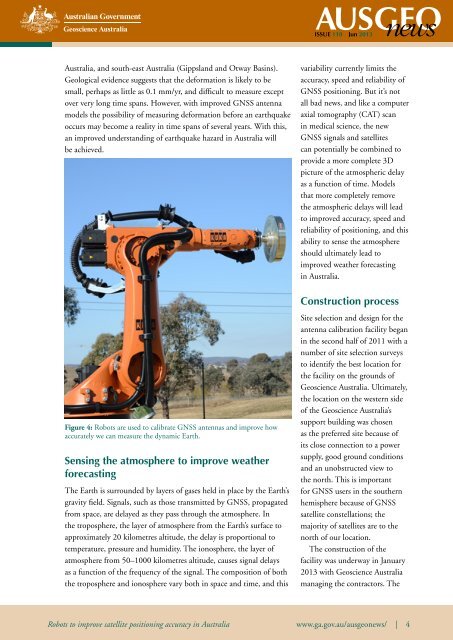Robots to improve satellite positioning accuracy in Australia
Robots to improve satellite positioning accuracy in Australia
Robots to improve satellite positioning accuracy in Australia
You also want an ePaper? Increase the reach of your titles
YUMPU automatically turns print PDFs into web optimized ePapers that Google loves.
AUSGEO NEWS ISSUE 110 Jun 2013<strong>Australia</strong>, and south-east <strong>Australia</strong> (Gippsland and Otway Bas<strong>in</strong>s).Geological evidence suggests that the deformation is likely <strong>to</strong> besmall, perhaps as little as 0.1 mm/yr, and difficult <strong>to</strong> measure excep<strong>to</strong>ver very long time spans. However, with <strong>improve</strong>d GNSS antennamodels the possibility of measur<strong>in</strong>g deformation before an earthquakeoccurs may become a reality <strong>in</strong> time spans of several years. With this,an <strong>improve</strong>d understand<strong>in</strong>g of earthquake hazard <strong>in</strong> <strong>Australia</strong> willbe achieved.Figure 4: <strong>Robots</strong> are used <strong>to</strong> calibrate GNSS antennas and <strong>improve</strong> howaccurately we can measure the dynamic Earth.Sens<strong>in</strong>g the atmosphere <strong>to</strong> <strong>improve</strong> weatherforecast<strong>in</strong>gThe Earth is surrounded by layers of gases held <strong>in</strong> place by the Earth’sgravity field. Signals, such as those transmitted by GNSS, propagatedfrom space, are delayed as they pass through the atmosphere. Inthe troposphere, the layer of atmosphere from the Earth’s surface <strong>to</strong>approximately 20 kilometres altitude, the delay is proportional <strong>to</strong>temperature, pressure and humidity. The ionosphere, the layer ofatmosphere from 50–1000 kilometres altitude, causes signal delaysas a function of the frequency of the signal. The composition of boththe troposphere and ionosphere vary both <strong>in</strong> space and time, and thisvariability currently limits the<strong>accuracy</strong>, speed and reliability ofGNSS <strong>position<strong>in</strong>g</strong>. But it’s notall bad news, and like a computeraxial <strong>to</strong>mography (CAT) scan<strong>in</strong> medical science, the newGNSS signals and <strong>satellite</strong>scan potentially be comb<strong>in</strong>ed <strong>to</strong>provide a more complete 3Dpicture of the atmospheric delayas a function of time. Modelsthat more completely removethe atmospheric delays will lead<strong>to</strong> <strong>improve</strong>d <strong>accuracy</strong>, speed andreliability of <strong>position<strong>in</strong>g</strong>, and thisability <strong>to</strong> sense the atmosphereshould ultimately lead <strong>to</strong><strong>improve</strong>d weather forecast<strong>in</strong>g<strong>in</strong> <strong>Australia</strong>.Construction processSite selection and design for theantenna calibration facility began<strong>in</strong> the second half of 2011 with anumber of site selection surveys<strong>to</strong> identify the best location forthe facility on the grounds ofGeoscience <strong>Australia</strong>. Ultimately,the location on the western sideof the Geoscience <strong>Australia</strong>’ssupport build<strong>in</strong>g was chosenas the preferred site because ofits close connection <strong>to</strong> a powersupply, good ground conditionsand an unobstructed view <strong>to</strong>the north. This is importantfor GNSS users <strong>in</strong> the southernhemisphere because of GNSS<strong>satellite</strong> constellations; themajority of <strong>satellite</strong>s are <strong>to</strong> thenorth of our location.The construction of thefacility was underway <strong>in</strong> January2013 with Geoscience <strong>Australia</strong>manag<strong>in</strong>g the contrac<strong>to</strong>rs. The<strong>Robots</strong> <strong>to</strong> <strong>improve</strong> <strong>satellite</strong> <strong>position<strong>in</strong>g</strong> <strong>accuracy</strong> <strong>in</strong> <strong>Australia</strong> www.ga.gov.au/ausgeonews/ | 4
















